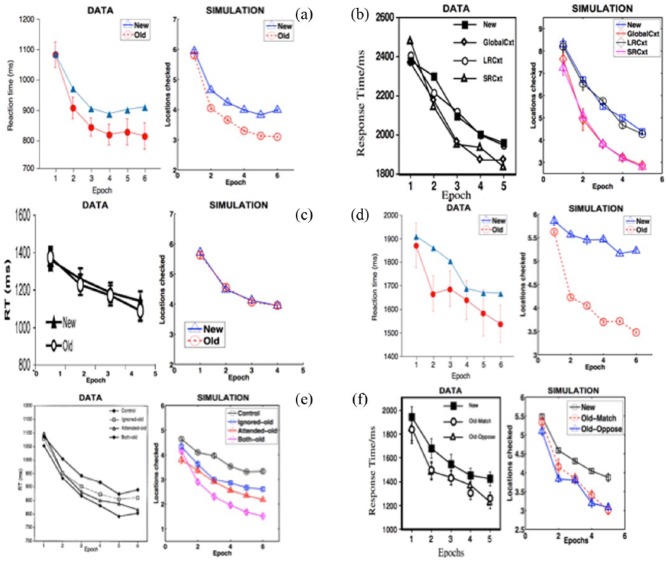Figure 16.
Some simulations of contextual cueing behavioural paradigms using the ARTSCENE Search model. (a)–(c) simulate spatial cueing paradigms, whereas (d)–(f) simulate object cueing paradigms. In all graphs, the x-axis represents training epoch grouped from blocks of trials, and the y-axis represents search reaction time for completing a trial. (a) Positive spatial cueing effects are the RT reductions for search in a familiar spatial context (Old condition) compared to a novel context (New condition). Data reprinted with permission from Chun (2000). (b) Spatial cueing effects can be mainly attributed to target-predictive positions closer to the target, such as those in the same visual hemifield. In the graphs, the conditions New, GlobalCxt, LRCxt, and SRCxt refer to novel, repeated, long-range, and short-range spatial contexts, respectively, with respect to the target position. Data reprinted with permission from Olson and Chun (2002; Experiment 2). (c) Negative cueing effects or context-induced search RT increases can arise at the single subject level due to focused attention. At the group level in which search RTs were averaged across subjects, there was no significant RT difference for search in a familiar spatial context (Old condition) or a novel one (New condition). Data reprinted with permission from Lleras and Von Mühlenen (2004; Experiment 3). (d) Object cueing effects are the RT reductions for search in a congruent or familiar object context (Old condition) compared to an incongruent or a novel context (New condition). Data reprinted with permission from Chun (2000). (e) Selective feature-based attention modulates contextual cueing. In the experiment and simulation, a search trial consisted of red and green items including the target whose colour was maintained and attended to throughout the entire session. Across blocks, the spatial configuration of distractors in a trial was randomly varied in the Control condition, but fully repeated in the Both-old condition. The Ignored-old and Attended-old conditions preserved spatial locations across blocks for distractors in the ignored or attended colour, respectively. Data reprinted with permission from Jiang and Chun (2001; Experiment 3). (f) Task-irrelevant colours did not affect spatial cueing. In the experiment and simulation, the target colour was non-predictable, either red or green. The context layouts were varied in the New condition, but preserved across blocks for half of the items that shared the target colour in the Old-Match condition. In contrast, the Old-Oppose condition preserved locations for half items that differed in colour from the target. Data reprinted with permission from Olson and Chun (2002; Experiment 4). Adapted with permission from Huang and Grossberg (2010).

